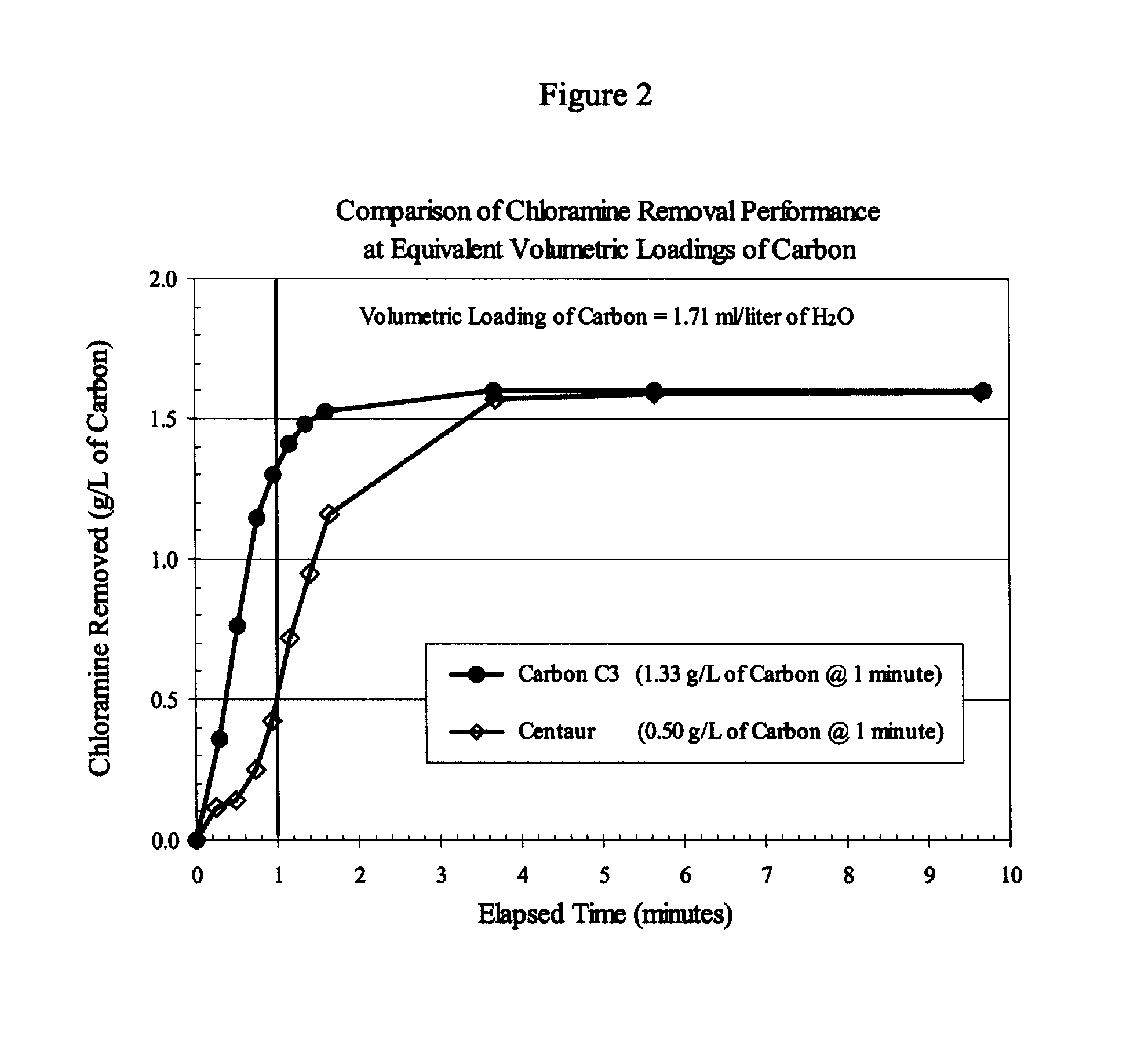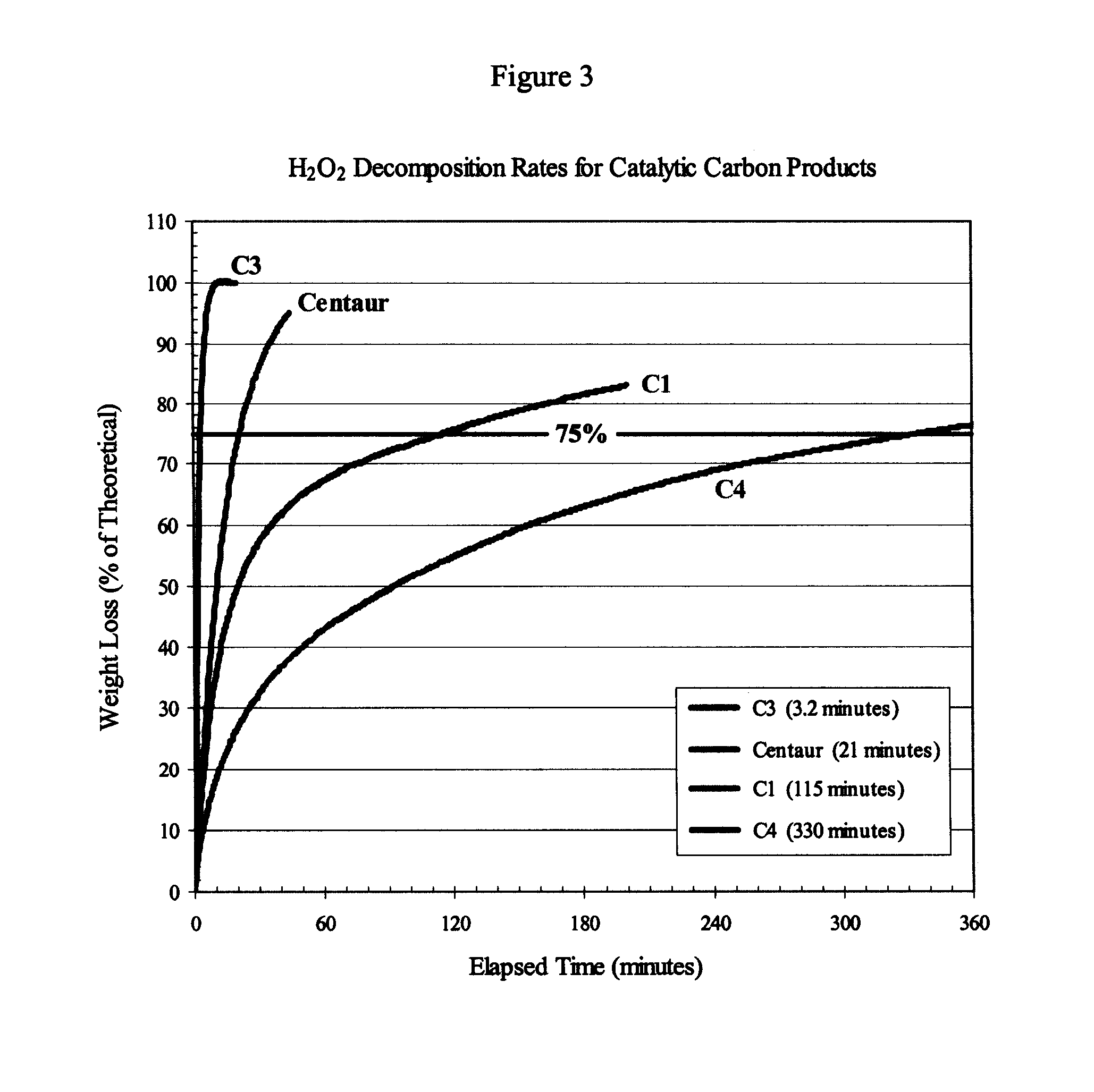Catalytic activated carbon for removal of chloramines from water
a technology of catalytic activated carbon and chloramine, which is applied in the direction of physical/chemical process catalysts, other chemical processes, separation processes, etc., can solve the problems of all nitrogen-poor chars and relatively poor nitrogen-poor carbonaceous feedstocks from which such carbons are produced, and achieve the effect of extracting a greater amount of chloramine from chloramine-contaminated drinking water more quickly
- Summary
- Abstract
- Description
- Claims
- Application Information
AI Technical Summary
Benefits of technology
Problems solved by technology
Method used
Image
Examples
example 1
[0032]400 g of water containing chloramine (about 3 ppm) was equilibrated at a temperature of 21° C. 200 mg (±1%) of the carbon test sample was added to the stirred solution and a stopwatch started to record elapsed time. 10 ml aliquots of the carbon / water suspension were removed at periodic intervals and immediately filtered to remove the carbon from treated water. The actual time of filtration of an aliquot of the carbon / water suspension was recorded as the elapsed time for that aliquot. The aqueous filtrates were analyzed for chloramine content immediately following collection of all aliquots of the carbon / water suspension. Working with one filtrate at a time, a DPD (N,N-diethyl-p-phenylenediamine) reagent “pillow” for total chlorine determination (Hach Company, Catalog Number 21056-69) was added to the filtrate (10 ml) and the sample vial shaken for 20 seconds to develop the characteristic magenta color of the “Wurster dye” DPD-oxidation product. The absorbance of the filtrate a...
example 2
[0036]The performance data discussed in Example 1 (FIG. 1 and Table I) were determined using equivalent weights of catalytic carbon products, namely 200 mg. However, POE and POU filters for water-treatment applications contain cartridges of certain standard dimensions, and therefore accommodate a certain fixed volume of filtration medium. Depending on the nature of the precursor material from which a carbon product is produced, the density of different catalytic carbon products can vary widely, resulting in different weights of the respective products in a fixed volume of a filter cartridge. For the case in point, the invention carbons were produced from wood, whereas the Centaur product was produced from coal. For comparable particle sizes, i.e., ≧90%-325 mesh, the apparent density of the coal-based Centaur product is about twice that of the wood-based invention carbons. In practice, this means that a cartridge filter of a given volume can hold twice the weight of the Centaur produ...
example 3
[0040]The t-¾-time is defined (U.S. Pat. Nos. 5,338,458, 5,356,849, and 5,470,748) as the time at which three-quarters (75%) of the maximum temperature rise has occurred during the decomposition of hydrogen peroxide by a carbon material. It is assumed that this time corresponds to 75% decomposition of the available hydrogen peroxide. In the surrogate “t-¾ time” test used to characterize the catalytic activity of the invention carbon products, the decomposition of the hydrogen peroxide solution was monitored through the weight loss resulting from the evolution of oxygen. In keeping with Calgon Carbon's definition, the “t-¾ time” was assumed to correspond to the point at which 75% of the theoretical weight loss of oxygen from the available hydrogen peroxide had occurred. The weight of carbon, volume of hydrogen peroxide solution, and concentration of the hydrogen peroxide solution were similar to those employed in the Calgon Carbon test. Similarly, the reaction medium was buffered at ...
PUM
| Property | Measurement | Unit |
|---|---|---|
| temperature | aaaaa | aaaaa |
| temperatures | aaaaa | aaaaa |
| temperatures | aaaaa | aaaaa |
Abstract
Description
Claims
Application Information
 Login to View More
Login to View More - R&D
- Intellectual Property
- Life Sciences
- Materials
- Tech Scout
- Unparalleled Data Quality
- Higher Quality Content
- 60% Fewer Hallucinations
Browse by: Latest US Patents, China's latest patents, Technical Efficacy Thesaurus, Application Domain, Technology Topic, Popular Technical Reports.
© 2025 PatSnap. All rights reserved.Legal|Privacy policy|Modern Slavery Act Transparency Statement|Sitemap|About US| Contact US: help@patsnap.com



